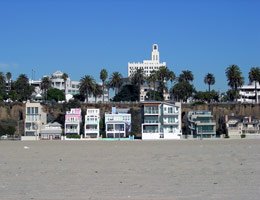Surfurbia
Coined by Reyner Banham in his Los Angeles. The Architecture of Four Ecologies (1971), the term surfurbia is used to describe the influence that the overwhelming trinomial of the three Ss (Sun, Sand and Surf) has on the construction of the contemporary metropolis. In the first place, surfurbia arises as a habitual process of suburbanization: Since it was founded, the city of Los Angeles was kept separate from the sea until in the early 20th century the coast became the declared objective of its expansion. This process, as in the remainder of North American cities, was based on an alliance with rail companies which permitted easy access from the downtown area to the first exclusive resorts of the periphery such as Santa Mónica, created as a result of the growing fondness for bathing of the Los Angeles bourgeoisie of the late 19th century.

Secondly, surfurbia arose from the unusual alliance encouraged by this suburbanization. In 1907, with the aim of promoting the coast as a weekend leisure destination, the Pacific Electric Railroad contracted the Hawaii surf pioneer George Freeth to give exhibitions of this eccentric and spectacular sport. This set off an explosive property development based on the seducing lure of tourism that would make Los Angeles one of the greatest maritime cities in the world.
Once the foundations of this development had been laid, surf would take charge of offering as from the 1950s an undisputed iconographic reference. In the words of Banham, few coastal invasions since the Vikings have been so colorful. During the second half of the century, and thanks to advances in the development of plastic materials as a result of war industry research, surf abandoned its initial elitist character and became a sport for the masses. In the metropolis of the Pacific, the beach established itself as the only public space in the city, on the same level as the highwat. Surfurbia is the alternative to the mechanized autopia, where the myth of individuality is fulfilled with the renaissance of Rousseau’s noble savage: With the agility of his naked muscles and the lightness of his board of foam and glass fibre, he manages to tame the mythical force of the ocean.
In the same way, in Banham’s surfurbia, the utopia of egalitarian society and the symbolic rejection of the consumer society are based on relaxation and the semi-nudity of immodest shorts and bikinis. In a city where spatial and social fragmentation grows in keeping with its size, surfurbia is a stronghold of optimism. Surfurbia is the triumph of hedonism in the contemporary metropolis. And it's here to stay.
Authors
Reyner Banham (1922-88) ) was one of the most influential critics of architecture, design, and popular culture from the 1950s to the 1980s. An engineer and historian by training, he was convinced that technology made society not only more exuberant, but above all more open and democratic.
His combination of academic rigor and sensitivity to the spontaneity of early pop set him against those who defended orthodox modernity, but placed him in a privileged position to understand the cultural implications of social and political change after the war. His first book, Theory and Design in the First Machine Age, is considered a key work for the overcoming of the Modern Movement in the 1960s. His Los Angeles. The Architecture of Four Ecologies is considered a work of reference for the understanding of the contemporary Californian megalopolis. According to the author himself, it is a book that could only be written after learning to drive, and can only be appreciated by drivers.
Bibliography
- BANHAM, Reyner. Los Angeles. The Architecture of Four Ecologies. Berkeley, Los Angeles, London: University of California Press, 2001 (1971)